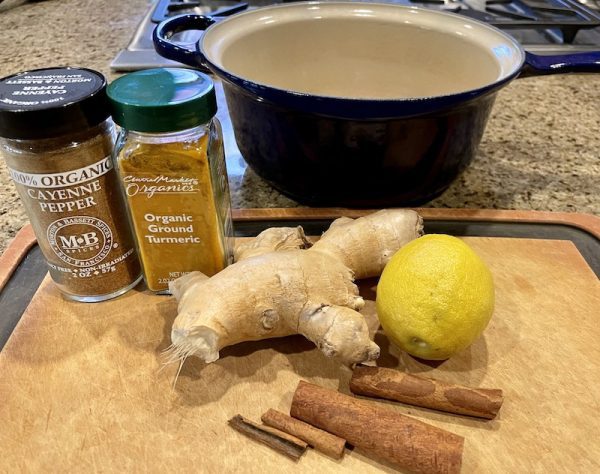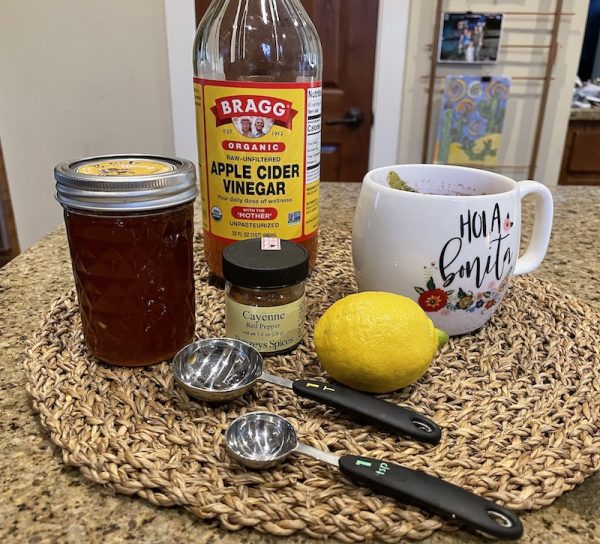4 Ways to Detox
Did you know your body has a continuous detoxification process to repairs and heal? But when your body’s detoxification systems become overloaded, toxins can remain active longer than your body can handle. This can cause symptoms such as:
- Bloating and digestive discomfort
- Skin issues
- Brain fog and mood swings
When toxins stay longer than your organs can handle, it can lead to chronic disease such as heart and autoimmune conditions, mental ill-health and/or cognitive decline.
Here are four effective ways to help your body detoxify after the holiday season with all its goodies, beverages, excess food and stress. Build them into regular habits to strengthen your immune system, and improve gut health and help protect your brain.
Flush out the Toxins
Make a Morning Detox Tea
Lemon Tumeric Tea – Nourish Move Love
Hydrate, detox and boost your immune system. Ginger, turmeric, cinnamon and cayenne pepper are anti-inflammatory and high in antioxidants. This tea is an excellent way to prevent/address colds and flus.

Apple Cider Detox Tea – Tasteaholics
Did you know that apple cider vinegar (ACV) has been consumed for thousands of years? Historical records show that apple juice was fermented into vinegar more than 5,000 years ago. ACV has antibacterial properties as well as health-promoting probiotics and enzymes. In addition to helping your body detox, using ACV regularly:
- Stabilizes blood sugar
- Lowers cholesterol
- Improves skin health
- Can relieve acid reflux

Prep a Pitch of InfusedWater
Here are 5 refreshing detox recipes from Posthood to get started. Or simply add about 1/4 – 1/3 cup of the following to a pitcher of water
- Cucumber, sliced
- Lemon, lime or grapfruit sliced
- Mint, chopped
- Grapefruit, lemon, lime,
Experiment with other herbs and fruits. Add sparkling water. It’s an effective way to replace sodas and diet beverages. In addition to hydrating and cleansing you will:
- boost your metabolism
- ease digestion and constipation
- enhance your energy level and focus
- help your skin
Dry Brush to Activate Your Lymphatic System
Think of your lymphatic system as the housecleaner of your immune system. The lymphatic system is a network of nodes, vessels, glands and organs. It carries the waste out of your tissues and into the blood stream to be filtered through your spleen.
Your skin is your largest eliminative organ. If it is clogged with dead skin cells and/or other impurities, its ability to eliminate toxins is handicapped.
Dry brushing is an ancient ritual that stimulates blood circulation and lymphatic system. It helps flush out waste and toxins. Keeping your lymphatic system functioning properly contributes to a better, more resilient immune response . It is directly related to your overall health.
How to Dry Brush?
- Use a natural bristle brush either a long handle or a grip so you can easily cover all areas of the body.
- Begin with the soles of your feet
- Using circular motions brush vigorously in this order: feet, legs, hands and arms, your back, and abdomen.
- Brush over each area several times, about 5-10 times.
Dry brushing exfoliates the skin. A nice benefit is minimizing cellulite. This happens by increasing blood circulation to the skins. It softens fat cells under your skin helping to release toxins from within
Take an Epsom Salt Bath
The two main ingredients of Epsom salt are magnesium and sulfate. Soaking in an Epsom salt bath is a mild form of magnesium therapy. Magnesium is an essential mineral that plays a role in over 300 enzymatic reactions in your body ranging from regulating blood pressure and supporting metabolism to keeping blood sugar levels stable and removing toxins. Sulfate can strengthen the walls of your digestive tract and make releasing toxins easier. The combination of both ingredients (magnesium and sulfate) stimulates detoxification pathways.
Heat is an excellent resource while cleansing. A warm bath promotes sweating, which may help your body draw out toxins from within releasing them through your pores.
It’s an ideal way to end the day. Healthy magnesium levels also boost brain neurotransmitters that are responsible for inducing sleep and reducing stress.
For More Empowerment
Detox Made Safe and Simple – Dr. Mark Hyman
Apple Cider Benefits and Uses – Dr. Axe
10 Holistic Treatments for Your Lymph – Chalkboard
10 Detox Bath Recipes – Dr. Axe
Originally posted January 2022
